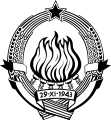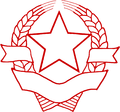Emblem of Yugoslavia
| Emblem of Yugoslavia | |
|---|---|
 | |
| Versions | |
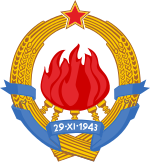 Emblem of FPR Yugoslavia (1946–1963). This version featured five torches that represented thebrotherhood and unityof the five Yugoslav nations. The sixth torch in the later version was added for the Bosnian Muslims. | |
 Emblem of Democratic Federal Yugoslavia (1943–1946). | |
| Armiger | Yugoslavia |
| Adopted | 1963 |
| Crest | Red star |
| Shield | Sixtorchesburning together |
| Supporters | Wheat |
| Other elements | Blue ribbon with a text imprinting the date: 29 November 1943 |
| Use | As official emblem ofYugoslavia |
Theemblem of Yugoslaviafeatured six torches, surrounded by wheat with a red star at its top, and burning together in one flame; this represented thebrotherhood and unityof the six federal republics forming Yugoslavia:Bosnia and Herzegovina,Croatia,Macedonia,Montenegro,SerbiaandSlovenia.The date imprinted was 29 November 1943, the day theAnti-Fascist Council for the National Liberation of Yugoslavia(AVNOJ) met inJajceon its second meeting and formed the basis for post-war organisation of the country, establishing a federal republic. This day was celebrated asRepublic Dayafter the establishment of the republic. The emblem of Yugoslavia, along with those of its constituent republics, are an example ofsocialist heraldry.
History
[edit]Kingdom of Yugoslavia
[edit]Thecoat of armsof the 1918–1941Kingdom of Yugoslavia(called theKingdom of Serbs, Croats and Slovenesuntil 1929) evolved from thecoat of arms of Serbia.Graphically the coats of arms were similar, featuring only two major differences, the first difference being the royal crowns. The royal Serbian coat of arms depicts theObrenovićdynastic crown, while the royal Yugoslav coat of arms depicted the rulingKarađorđevićdynastic crown.
The second difference involved the shield surmounted on the white double-headed eagle. The previousSerbian coat of armsdepicted only theSerbian tetragrammatic cross,representing only theSerbiannation. When Yugoslavia formed in 1918, the surmounted shield changed to include symbolism for the newly integratedCroat(red-and-white chequerboard) andSlovenenations, as the three official nations of Yugoslavia. The coat of arms includes three golden six-pointed stars arranged in the form of an upside-down triangle, adopted from the Slovenian coat-of-arms of the family of theCounts of Celje.[1]An image of the royal Yugoslav coat of arms appears on the 10-Yugoslav dinarbanknote of 1926.[2]
-
First coat of arms (1918–1921) of theKingdom of Serbs, Croats and Slovenes
-
Greater coat of arms ofKingdom of Yugoslavia(1921–1941)
-
Lesser coat of arms ofKingdom of Yugoslavia(1921–1941)
Socialist Federal Republic of Yugoslavia
[edit]
During World War II (1943–1945), the Yugoslav state was namedDemocratic Federal Yugoslavia(DFY), in 1945 it was renamedFederal People's Republic of Yugoslavia(FPRY), and again in 1963 intoSocialist Federal Republic of Yugoslavia(SFRY). The emblem of socialist Yugoslavia was designed in 1943 and remained in use up to 1963, when the country underwent reforms and was renamed for the final time. It featured five torches surrounded by wheat and burning together in one flame; this represented thebrotherhood and unityof the five nations of SFRY:Croats,Macedonians,Montenegrins,SerbsandSlovenes.TheBosniakswere not represented as a constituent nation, in spite of the fact that there existence of Bosniaks self-identifying as a nation had taken place since the late 19th century through the influence of figures such asMehmed Kapetanović.[citation needed]
As part of the 1963 reforms, the name of the country was changed into Socialist Federal Republic of Yugoslavia and its emblem was redesigned to represent six Yugoslav federal republics (instead of the five nations). The new emblem was the final version with six torches, and was in official use until 1993 (past the country's dissolution in 1992). The date in the insignia remained in the new emblem.
-
Stamp version used on printed materials
-
Emblem ofAVNOJduring first session (1942–1943)
-
Emblem ofAVNOJduring second session (1943)
-
Emblem ofDemocratic Federal Yugoslavia(1943–1946)
-
Emblem ofFPR Yugoslavia(1946–1963)
-
Emblem ofSFR Yugoslavia(1963–1992)
Republic emblems
[edit]The emblems of theYugoslavsocialist republics were defined by each of its six constituent republics. Emblems appeared as a symbol of statehood on the documents of republican level, for example on the signs of the republican institutions, onwatermarksof schooldiplomas,etc.
The emblems included old historical symbols where they could demonstrate historical compatibility with the new socialist political system – see Croatian and Serbian traditional emblem in the middle of their coats of arms; also Slovenian MountTriglavwas recognized as a symbol ofSlovenian Liberation Frontduring the National Liberation War duringWorld War II.Where the old symbols were deemed inappropriate (the traditional cross on the Serbian coat of arms, ethnic or religious coat of arms for Bosnia and Herzegovina, the former traditionally monarchist symbol for Montenegro or the historical lion for Macedonia), prominent features or unofficial national symbols were added, e.g. MountLovćenfor Montenegro, or a pair ofchimneysfor Bosnia and Herzegovina. The same with the federal Yugoslav emblem: all separate republican emblems featured ared starand wheat, or other important plants from that region. The individual emblems of the six Yugoslav socialist republics were as follows:
| Republic | Emblem | Author | Republic-specific features | Present-day coat of arms | |
|---|---|---|---|---|---|
| Bosnia and Herzegovina | 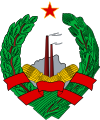
|
Unknown | Plants | Conifertwig(left),Deciduoustwig(right), two sheaves ofwheat(lower middle portion) | 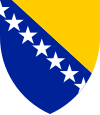 Coat of arms of Bosnia and Herzegovina |
| Landscapes, geographic features |
Silhouette ofJajce | ||||
| Industry | two factorychimneys | ||||
| Ornaments | red ribbon | ||||
| Croatia | 
|
Antun Augustinčić andVanja Radauš[3] |
Plants | Wheat |  Coat of arms of Croatia |
| Landscapes, geographic features |
Adriatic Sea,rising sun | ||||
| Industry | Ironanvil | ||||
| Ornaments | Chequy | ||||
| Macedonia | 
|
Vasilije Popović–Cico[4] | Plants | Garlandof wheat,tobacco leavesandpoppy buds |  Emblem of North Macedonia |
| Landscapes, geographic features |
River Vardar,Mount Korab,sunrise,sky | ||||
| Industry | – | ||||
| Ornaments | ribbonwith traditionalMacedonian embroidery | ||||
| Montenegro | 
|
Milan Božović[5] andMilo Milunović[5] |
Plants | laurel wreath | 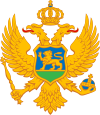 Coat of arms of Montenegro |
| Landscapes, geographic features |
Mount Lovćen,[6]Adriatic Sea | ||||
| Industry | – | ||||
| Ornaments | Montenegrin[6]tricolour ofPan-Slavic colors | ||||
| Serbia | 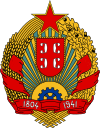
|
Đorđe Andrejević Kun | Plant | sheafofwheat(left), sheaf ofoakleaveswithacorns(right) |  Coat of arms of Serbia |
| Landscapes, geographic features |
sunrise, sky | ||||
| Industry | cog-wheel | ||||
| Ornaments | red track (with inscriptions),Serbian traditional symbol | ||||
| Slovenia | 
|
Branko Simčič | Plants | wheat,leavesoflinden | 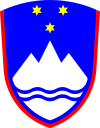 Coat of arms of Slovenia |
| Landscapes, geographic features |
Triglav,sea[7] | ||||
| Industry | – | ||||
| Ornaments | redribbon | ||||
See also
[edit]- Flag of Yugoslavia
- List of Yugoslav flags
- Coat of arms of Bosnia and Herzegovina
- Coat of arms of Croatia
- Emblem of North Macedonia
- Coat of arms of Montenegro
- Coat of arms of Serbia
- Coat of arms of Slovenia
- Socialist heraldry
References
[edit]- ^Fugger Germandik, Rolanda (2013).Grofje Celjski med zgodovino in mitom[Counts of Celje Between History and Myth] (in Slovenian). Zgodovinsko društvo.ISBN978-961-6845-04-5.
- ^10 dinar note of 1926ArchivedFebruary 24, 2012, at theWayback Machine
- ^Stuparić, Darko.Diplomati izvan protokola: ambasadori Titove Jugoslavije,Centar za kulturnu djelatnost Saveza socijalističke omladine Zagreba, Zagreb, 1978., p. 75.
- ^Jonovski, Jovan.Coats of arms of Macedonia,Macedonian Herald,Electronic Version, heraldika.org.mk, No. 3, March 2009, p. 9.
- ^abMarkuš, Jovan B.Grbovi, zastave i himne u istoriji Crne Gore(Библиотека Свети Петар Цетињски), "Svetigora" (Izdavačko-informativna ustanova Mitropolije Crnogorsko-primorske), Cetinje, 2007., p. 47-48.,ISBN978-86-7660-054-0
- ^abExcerpt from theConstitution of the Socialist Republic of Montenegro(1963)in:Guć, Nedeljko. (ed.)Društveno-političko uređenje, pravosuđe, uprava,(Zbirke propisa I-IV), knj. 1, Prosveta, Beograd, 1967,p. 303.
Члан 7.
Грб Социјалистичке Републике Црне Горе представља поље окружено ловоровим вијенцем који је доље повезан црногорском заставом. Између врхова ловоровог вијенца је петокрака црвена звијезда, а у средини поља представљен је Ловћен. Позади Ловћена с неколико вијуга представљено је Јадранско море.— Guć, 1967, 303 - ^8. členUstave Socialistične republike Slovenije (1974)
External links
[edit]- National symbols of Yugoslavia
- Coats of arms of former countries
- Socialist Federal Republic of Yugoslavia
- Bosnia and Herzegovina coats of arms
- Croatian coats of arms
- Montenegrin coats of arms
- Serbian historical coats of arms
- National emblems
- Coats of arms of communist states
- Coats of arms with wheat
- Coats of arms with stars
- Coats of arms with flames




